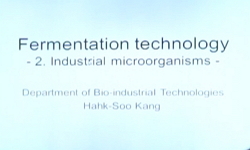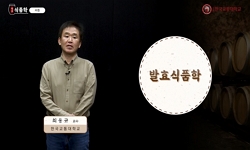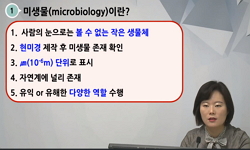Kimchi is the Korean traditional fermented food which is made of the vegetables and various seasonings. Since kimchi is not processed with sterilization, there are diverse microorganisms and the number of lactic acid bacteria (LAB) are dominant. The r...
http://chineseinput.net/에서 pinyin(병음)방식으로 중국어를 변환할 수 있습니다.
변환된 중국어를 복사하여 사용하시면 됩니다.
- 中文 을 입력하시려면 zhongwen을 입력하시고 space를누르시면됩니다.
- 北京 을 입력하시려면 beijing을 입력하시고 space를 누르시면 됩니다.
Characterization and Potential of Bacteriophage for Lactobacillus plantarum Control in Kimchi Fermentation
한글로보기https://www.riss.kr/link?id=T15676163
- 저자
-
발행사항
성남 : 가천대학교 일반대학원, 2020
-
학위논문사항
학위논문(석사) -- 가천대학교 일반대학원 , 식품생명공학과 식품생명공학전공 , 2020. 8
-
발행연도
2020
-
작성언어
영어
- 주제어
-
발행국(도시)
경기도
-
형태사항
99 ; 26 cm
-
일반주기명
지도교수: 박종현
-
UCI식별코드
I804:41005-200000340148
- 소장기관
-
0
상세조회 -
0
다운로드
부가정보
다국어 초록 (Multilingual Abstract)
Kimchi is the Korean traditional fermented food which is made of the vegetables and various seasonings. Since kimchi is not processed with sterilization, there are diverse microorganisms and the number of lactic acid bacteria (LAB) are dominant. The representative LAB in kimchi are the genera of Weissella, Leuconostoc, and Lactobacillus. It was reported that Weissella and Leuconostoc are dominant at the early and mid-stage of fermentation and Lactobacillus is predominant at the late stage of fermentation. Especially, Lb. plantarum is known to be related to the kimchi acidification. The recent studies suggested that many environmental factors affect the kimchi fermentation and the bacteriophages may be a significant determinant of kimchi microbial dynamics. In this study, three different bacteriophages, ΦLCK27, ΦLMB6, and ΦLP12116, were isolated from kimchi and their stability in the diverse conditions like kimchi environment were examined. All of three phages were stable at high salinity, high organic acid concentration, and high acidic conditions and then, it indicated that three phages can survive in kimchi environment. Among the three bacteriophages, Lb. plantarum infecting phage, ΦLP12116, is selected and evaluated the control ability of Lb. plantarum. In kimchi environment, Lb. plantarum showed about 2.2 log CFU/ml of reduction by treating ΦLP12116 compared with non-phage treated Lb. plantarum. Therefore, this study suggested that the growth of Lb. plantarum can be controlled by treating bacteriophage in kimchi environment and it showed the possibility of delay in kimchi acidification by treating bacteriophage.
목차 (Table of Contents)
- ABSTRACT I
- TABLES OF CONTENTS III
- LIST OF TALBES VII
- LIST OF FIGURES VIII
- ABSTRACT I
- TABLES OF CONTENTS III
- LIST OF TALBES VII
- LIST OF FIGURES VIII
- I. Introduction 1
- 1.1 Kimchi 1
- 1.1.1. Factors affecting kimchi fermentation 3
- 1.1.2. Microbial succession in kimchi fermentation 5
- 1.2. Bacteriophage 8
- 1.2.1. Correlation of LAB and bacteriophage in food fermentation 11
- II. Materials and Methods 12
- 2.1. Bacterial strains and culture conditions 12
- 2.2. Profiling of LAB and bacteriophage from kimchi 17
- 2.2.1. LAB and bacteriophage profiling of several types of kimchi 17
- 2.2.1.1. Collection of several types of kimchi 17
- 2.2.1.2. Total bacteria counting 17
- 2.2.1.3. LAB counting 18
- 2.2.1.4. Virus like particle (VLP) counting 18
- 2.2.1.5. Measurement of pH 20
- 2.2.1.6. Measurement of salinity 20
- 2.2.2. LAB and bacteriophage profiling of fermenting kimchi 21
- 2.2.2.1. Preparation of kimchi 21
- 2.2.2.2. Total bacteria counting and LAB counting 22
- 2.2.2.3. VLP counting 22
- 2.2.2.4. Measurement of pH and salinity 22
- 2.2.2.5. Measurement of titratable acidity 23
- 2.3. Isolation and Characterization of bacteriophage from kimchi 24
- 2.3.1. Isolation of bacteriophage from kimchi 24
- 2.3.1.1. Host bacteria isolation from kimchi 24
- 2.3.1.2. Bacteriophage isolation from kimchi 24
- 2.3.1.3. Identification of host bacteria of isolated bacteriophages 25
- 2.3.2. Characterization of bacteriophage from kimchi 26
- 2.3.2.1. Determination of host range of isolated bacteriophages 26
- 2.3.2.2. Efficiency of Plating (EOP) assay 26
- 2.3.2.3. One-step growth curve assay 27
- 2.3.2.4. Morphology of isolated bacteriophages 28
- 2.3.2.5. Restriction fragment pattern analysis 28
- 2.3.2.6. Bacterial challenge assay 29
- 2.4. Effects of various environmental factors on isolated bacteriophages viability 30
- 2.4.1. Effect of temperature on isolated bacteriophages 30
- 2.4.2. Effect of pH value on isolated bacteriophages 30
- 2.4.3. Effect of organic acid on isolated bacteriophages 31
- 2.4.4. Effect of high salinity on isolated bacteriophages 32
- 2.5. Control of Lb. plantarum with Lb. plantarum phage in kimchi fermentation 33
- 2.5.1. Growth inhibition assay for Lb. plantarum 33
- 2.5.2. Growth inhibition of Lb. plantarum in kimchi environment 34
- III. Results and Discussion 35
- 3.1. Profiling of LAB and bacteriophage from kimchi 35
- 3.1.1. LAB and bacteriophage profiling of several types of kimchi 35
- 3.1.2. LAB and bacteriophage profiling of fermenting kimchi 37
- 3.1.2.1. Quantitative analysis of total bacteria, LAB, and bacteriophage during Nabak-kimchi fermentation 37
- 3.1.2.2. Changes of pH value, titratable acidity, and salinity during Nabak-kimchi fermentation 39
- 3.2. Isolation and Characterization of bacteriophage from kimchi 41
- 3.2.1. Isolation of bacteriophage from kimchi 41
- 3.2.1.1. Host bacteria isolation from kimchi 41
- 3.2.1.2. Bacteriophage isolation from kimchi 41
- 3.2.1.3. Identification of host bacteria of isolated bacteriophages 42
- 3.2.2. Characterization of bacteriophage from kimchi 43
- 3.2.2.1. Determination of host range of isolated bacteriophages 43
- 3.2.2.2. Efficiency of Plating (EOP) assay 47
- 3.2.2.3. One-step growth curve assay 49
- 3.2.2.4. Morphology of isolated bacteriophages 53
- 3.2.2.5. Restriction fragment pattern analysis 57
- 3.2.2.6. Bacterial challenge assay 59
- 3.3. Effects of various environmental factors on isolated bacteriophages viability 63
- 3.3.1. Effect of temperature on isolated bacteriophages 63
- 3.3.2. Effect of pH value on isolated bacteriophages 67
- 3.3.3. Effect of organic acid on isolated bacteriophages 71
- 3.3.3.1. Effect of lactic acid on isolated bacteriophages 71
- 3.3.3.2. Effect of acetic acid on isolated bacteriophages 75
- 3.3.4. Effect of high salinity on isolated bacteriophages 79
- 3.4. Control of Lb. plantarum with Lb. plantarum phage in kimchi fermentation 82
- 3.4.1. Growth inhibition assay for Lb. plantarum 82
- 3.4.2. Growth inhibition of Lb. plantarum in kimchi environment 86
- IV. Conclusion 89
- References 90











